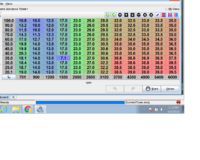So I've read some articles about advancing idle timing to the point where the vacuum and/or idle speed is highest then "backing it off" a degree or so to prevent pinging. This is the old school hot rod technique which while sipping my Manhattan last night I thought might have some merit. I suppose the theory is that idle increases because the higher timing makes the engine fire more precisely and efficiently, hence idle speed goes up without any additional fuel. Then they always say you have to watch out because your all-in timing will be way too high unless you get your distributor recurved. Well that's not a problem with the 123 because it can be recurved in 1 minute. Then I made another Manhattan and surfed eBay while contemplating this further.
Today I hooked up the laptop to the 123 and manually advanced my timing from the 10 BTDC where it was currently set. Advancing it from 10 to 20 increased the rpm from 950 to 1200. If I went higher it started diminishing returns so I kept it at 20. No pinging at idle or off it.
So then I recurved to go from 20 idle to 36 all in at the same limit as before. My total "mechanical advance" went from 26 before to 16 now with the elimination of the 10 degrees at idle. I then backed the throttle screw out and adjusted mix screws for AFR on the triple webers to get back to 950 at idle. Triple webers are sensitive to throttle plate/first progression hole position so this technique can also be used to dial that in. They also say triples "like more advance early on" so this certainly accomplishes that.
Result? Eliminated a slight off-idle hesitation from before and it accelerates way better with no pinging. Transition AFR is a half point leaner than before (I was a little rich there but I've let it go as a triple weber quirk, now it's better) and runs great. Perhaps it's because I've eliminated an area of advance that the engine ineficiently ran through while accelerating off idle?
Anyone ever try this or have any caveats for idle advance at 20? Want to try it yourself and report back? The improved idle with less throttle screw tells me that it is more efficient now. I am getting higher AFR's on overrun because the less-open throttles are dumping less fuel in than before. Here is the new curve:

Today I hooked up the laptop to the 123 and manually advanced my timing from the 10 BTDC where it was currently set. Advancing it from 10 to 20 increased the rpm from 950 to 1200. If I went higher it started diminishing returns so I kept it at 20. No pinging at idle or off it.
So then I recurved to go from 20 idle to 36 all in at the same limit as before. My total "mechanical advance" went from 26 before to 16 now with the elimination of the 10 degrees at idle. I then backed the throttle screw out and adjusted mix screws for AFR on the triple webers to get back to 950 at idle. Triple webers are sensitive to throttle plate/first progression hole position so this technique can also be used to dial that in. They also say triples "like more advance early on" so this certainly accomplishes that.
Result? Eliminated a slight off-idle hesitation from before and it accelerates way better with no pinging. Transition AFR is a half point leaner than before (I was a little rich there but I've let it go as a triple weber quirk, now it's better) and runs great. Perhaps it's because I've eliminated an area of advance that the engine ineficiently ran through while accelerating off idle?
Anyone ever try this or have any caveats for idle advance at 20? Want to try it yourself and report back? The improved idle with less throttle screw tells me that it is more efficient now. I am getting higher AFR's on overrun because the less-open throttles are dumping less fuel in than before. Here is the new curve:
Last edited:

